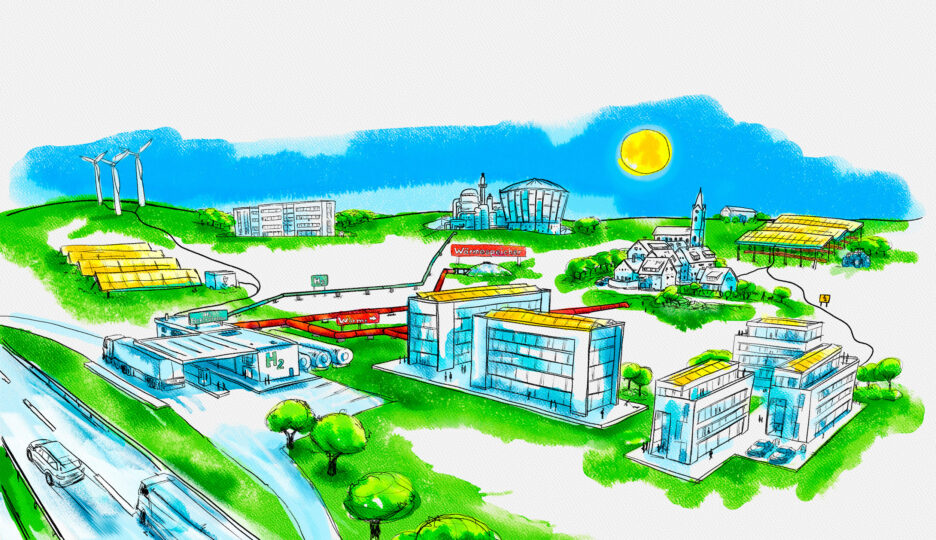H2 Quarter
Back to project overviewProject description
The idea behind the "H2-Quartier" research project originated from the "Klimaquartier Neue Weststadt Esslingen" pilot project, in which the renewable waste heat from the electrolyser can cover around half of the buildings' heating requirements. This idea of the Power-to-Gas&Heat approach ("P2G&H") is being extended to other district locations and examined on a larger scale as part of the "H2-Quartier" research project. The overall picture of the energy system is being taken further with a view to hydrogen. The transformation to a climate-neutral heat and power supply for neighborhoods is a Herculean task for the coming decades. The "P2G&H" approach can make a contribution to this.
The project comprises six districts in urban and suburban areas, four of which are located in the Stuttgart region alone. These are supplemented by the Dietenbach district in Freiburg im Breisgau and a coherent analysis of the towns of Wertheim and Bad Mergentheim in the Main-Tauber district. All six locations each comprise larger commercial areas and/or several hundred residential units.
Within the project, preparations for the implementation of electrolysis plants with waste heat utilization in inner-city and peri-urban areas are being carried out in cooperation with the network partners. This preliminary work will promote the development of energy-efficient and climate-neutral urban districts and increase their chances of implementation. The results will then be incorporated into the implementation planning. The implementation analyses will be used to derive generally transferable and detailed planning, implementation and marketing recommendations, which will be published in the final report. The information is bundled here in a cluster approach, in which the findings from each individual location are collected and analyzed together.
The declared aim of the project is to prepare the implementation of future-oriented districts in connection with the "P2G&H" approach and the production of green hydrogen. In the cluster approach, the challenges are bundled and the solution approaches are developed together (collective problem solving). Through the cluster structure, the findings of the various stakeholders are collected and exchanged across neighborhoods (networking platform), from which recommendations for action ("best practice") are derived for the next project generation.
Within a comprehensive basic section, the system of the P2G&H approach is analyzed, a market analysis and an outlook on system technology are developed, regulatory barriers are identified and user and operator feedback is collected from existing electrolyser plants. Existing and future business and operator models will also be analyzed.
In a further comprehensive implementation preparation phase, the technological, ecological and economic challenges involved in the decentralized production of green hydrogen at the specific district locations will be investigated. Further components of the investigation include, for example, the approvability of H2 technology, the potential for using waste heat, the logistics for marketing "green hydrogen" as well as the necessary measurement and billing technologies and, last but not least, public acceptance. The technological solutions for the production and marketing of "green hydrogen" and the use of waste heat and oxygen are being developed in close cooperation with local stakeholders. The preparatory steps required for the implementation of a climate-neutral district in the context of P2G&H will then be carried out in each district.
A cluster approach will be pursued across all locations. This joint consideration of the neighborhood projects opens up opportunities that would not be possible if they were considered separately, simply due to the interrelationships in terms of content and timing. Instead of an isolated approach for each individual neighbourhood, the collective approach should enable the implementation of forward-looking pilot neighbourhoods and the development of best practices for implementing the energy transition in the neighbourhoods.
- Stadtwerke Esslingen GmbH & Co. KG
- Stadtwerke Winnenden GmbH & Co. KG
- Georg Oest Mineralölwerk GmbH & Co. KG
- City of Freiburg im Breisgau
- LBBW Immobilien Kommunalentwicklung GmbH
- Stadtwerke Wertheim GmbH
- Stadtwerke Tauberfranken GmbH
The project is divided into eight work areas (AB). These work areas are each subdivided into work packages (WP).
AB 1: Fundamentals and "Lessons Learned" P2G&H
WP 2 - 7: Climate-neutral energy supply in urban and suburban areas
AB 8: "Best practice" for implementing the energy transition in the districts

